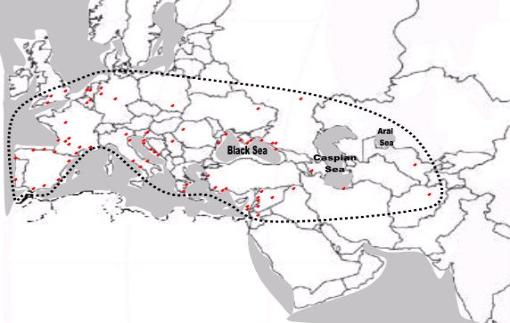| Adapted for the Internet from: Why God Doesn't Exist |
| Not education, but urbanization causes infertility |
- 1.0 Exponential growth ends when a species attains high densities
At the start of the 19th Century, Malthus observed that human population tends to multiply exponentially whereas the supply
of food progresses at an arithmetic pace. He predicted that the point at which we reach starvation is only a matter of time.
Darwin was soon to convert Malthus’s theory into a universal law:
- “ Every being... must suffer destruction during some period of its life... otherwise,
on the principle of geometrical increase, its numbers would quickly become so
inordinately great that no country could support the product... It is the doctrine
of Malthus applied with manifold force to the whole animal and vegetable
kingdoms; for in this case there can be no artificial increase of food, and no
prudential restraint from marriage… There is no exception to the rule that every
organic being naturally increases at so high a rate, that if not destroyed, the
earth would soon be covered by the progeny of a single pair… we may
confidently assert, that all plants and animals are tending to increase at a
geometrical ratio, that all would most rapidly stock every station in which they
could any how exist, and that the geometrical tendency to increase must be
checked by destruction at some period of life.” [1]
These perceptions have become ingrained in the minds of most people who, like Darwin, mistakenly believe that Mother
Nature controls demographics through death-end mechanisms. Most people have been brainwashed to believe that if the
tigress produces too many cubs and population exceeds the carrying capacity, The God of Starvation will punish the sons
for the sins of their fathers.
Contemporary Malthusians perpetuate the Darwinian wisdom that unless we do something quickly – short of killing people –
humans will soon spill over into outer space:
- “ As Malthus... and Darwin... understood, in the absence of limitations on
resources, i.e., space and food, populations will grow exponentially.” [2]
Brown sounds the alarms and urges decision-makers to attain population stability through family planning before it’s too
late:
- “ Slowing world population growth means that all women who want to plan
their families should have access to the family planning services they need.
Unfortunately, at present 201 million couples cannot obtain the services they
need to limit the size of their families. Filling the family planning gap may be
the most urgent item on the global agenda.” [3]
McMichael proposes a one-child per couple limit. [4] Hopfenberg and Pimentel suggest producing less food. [5] And so on.
These predictions, summary conclusions, and recommendations are a bit disconcerting in light of the contradicting facts.
On the one hand, we have the exceptional case of the Neanderthals. Despite having abundant food they never managed to
cover the Earth as Darwin predicted. In fact, their entire empire from the start of their species perhaps 500,000 years ago to
when they finally succumbed 30,000 years ago, barely got beyond Europe (Fig. 1). If there is no exception to Darwin’s
exponential ‘rule’, what stopped Neanderthal from ‘stocking every station in which they could exist?’ It is to note that the
Neanderthal were the top predators in their region, had ample sources of food at their disposal (as indicated by the
subsequent expansion of Man), and were already in remission 10,000 years before their final demise. Another example is
the famous T-Rex, who with his partner Triceratops never made it past the U.S. and Canada (Fig. 2). The paleontologist may
argue that an asteroid stopped the dinos from expanding further, but then he misses the point. The point is that not a single
species that ever existed on Earth has complied with Darwin's 'prediction.' So maybe it's time to question whether there is
something wrong with his 'law.'
- ________________________________________________________________________________________
- Last modified 03/03/08
- Copyright © by Nila Gaede 2008

| rural life |
| urban life |
It is pertinent to note that food is not a factor limiting Man's demographic expansion. Cohen [6] and Meyer [7] mention existing
technologies that allow us to produce much more of it than is currently available. Whereas hunter-gatherers and agrarian
societies were at the mercy of the elements, contemporary famines and malnutrition are the result of pricing and distribution
policies. [8] If we now consider that we have for the most part conquered contagious diseases and are living longer, what is it
that prevents us from expanding exponentially? Why did Darwin’s prediction fail to come true? In other words, why is it that
although food is and can be made readily available in greater quantities than we can consume, the world population is not
expanding at a faster rate? Better yet, why is the human population growth rate actually falling? Are we deliberately depriving
people of food?
The savvy demographer has a ready answer. The slowdown in growth has nothing to do with Malthus and Darwin being
wrong. The decrease in fertility and birth rates is the result of successful international projects. [9] [10] If the average woman
has fewer children today it is because policy-makers proactively suppressed them, in extreme cases through compulsion [11]
or without the consent of the sterilized women. [12] In most cases, women practice voluntary control through an entire host
of methods (e.g., IUDs, abstention, rhythm method, condoms, etc.). Indeed, most people casually associate a negative trend in
fertility with a positive trend in education:
- “ Literacy among women is associated with low fertility, low infant mortality
and better health of children.” [13]
“ Fertility is a function of education (primarily of the woman) and income,
i.e. the less poor you are, and more educated you are, the less children you
have, and less the population growth rate of your community.” [14]
I believe that demographers routinely draw the wrong conclusions from raw data. A famous joke has it that whether you drink
wine with water, bourbon with water, or vodka with water you get drunk. Therefore, since water is the common denominator,
we should conclude that water makes you drunk. The demographers apply this logic when they conclude that the numbers
show a correlation between fertility and education and, more stunningly, an inverse relation between fertility and wealth.
Unfortunately, they disseminate their findings as truth and people swallow it lock, stock, and barrel because the conclusion
emanates from authority.
I have a personal anecdote that exemplifies why fertility has little to do with the level of schooling that women receive. While
living in Colombia, I met a lady who was a servant in a household. She was an uneducated woman who came from the
countryside. She told me that her father had relations with several women in her village, the legal wife and four or five others
on the side. Each of these women had from 10 to 15 children from this man. She told me that she was one of 15 children from
the legitimate wife and laughed that the entire village looked like her. This woman had come to the big city, Bogota, to look for
work. She had been married for 7 years and had only one child. I asked her when she was going to catch up to the glory of her
mother and step mothers. She instantly said, ‘Nooooooooo. I’ll never have any more kids, God willing!’ I asked her why. She
said that she barely had time and money to take care of her son. In fact, sometimes she would ask her boss if she could bring
the boy to work with her because she had no one to take care of him. She would take those opportunities to feed the boy on
the side while doing the cooking. At the time of our chat, she was also in the process of separating from her husband.
The lesson is that this woman had not learned family planning at school and in fact was quite uneducated in a formal sense.
She surely did not take any family planning courses. She learned it the hard way, the way a tigress learns it in the wild:
intuitively. She acquired a healthy level of street smartness, realizing that city life did not afford the luxury of having children.
I learned then that it is not really education that affects fertility. It is the migration from the country to the city. Once a woman
is in a high density region, she stops having children. It is the type of life that women have to live in the city that forces them
to postpone children, sometimes indefinitely. City life requires and/or induces most women to either work or go to school.
The economic constraints for most women are such that there is no room in their lives for babies. Demographers have
wrongly concluded that it is education and higher incomes which has stopped the birth rate. They reason that urban women
are better educated than country girls and credit family education programs in underdeveloped nations for the success when
it is really urbanization that forces infertility upon women.
What has happened in the last 40 or 50 years around the world is that people have moved from the country to the cities:
- “ Aside from the growth of population itself, urbanization is the dominant
demographic trend of our time. In 1900, 150 million people lived in cities. By
2000, it was 2.9 billion people, a 19-fold increase. By 2007 more than half of
us will live in cities—making us, for the first time, an urban species.” [15]
- “ The 2005 Revision of the UN World Urbanization Prospects report described
the 20th century as witnessing 'the rapid urbanization of the world’s population',
as the global proportion of urban population rose dramatically from 13% (220
million) in 1900, to 29% (732 million) in 1950, to 49% (3.2 billion) in 2005. The
same report projected that the figure is likely to rise to 60% (4.9 billion) by 2030.” [16]
Are you a policy maker? Do you want to stop population growth today? Then follow my advice. Just relocate every woman
in the world, ignorant or intelligent, to cosmopolitan areas. The lifestyle simply makes it impossible to have children for the
average woman. You simply cannot have 10 children in a two-bedroom apartment nor do you have time or money for them.
It doesn’t matter how educated the woman is or whether she lives in China, Oman, Colombia or the U.S. Place her in a
crowded city and your exponential population problems are over. Of course, I will support my conclusions with more than
just an anecdote.
Fig. 1 The Neanderthal Empire (300 to 30 kya) |
| Red dots indicate verified or suspected settlements. (It is likely that they also inhabited Northern Africa along the Mediterranean Sea and farther east -- not shown.) Essentially, the Neanderthals never got past Europe and the Middle East. This is very strange in light of Darwin's prediction that, in the presence of abundant food, a species will overflow the planet. |

The T-Rex Empire (67 to 65 mya) |
| The Western Interior Seaway receded during the last 20 million years of the Cretaceous. Dots indicate sites where T-Rex fossils have been found. I use dotted lines to enclose hypothetical regions where T-Rexes and Triceratopses probably lived. (A slightly more primitive version of T-Rex known as Tarbosaurus bataar has also been found in Mongolia.) |

- Module main page: The mechanism behind background extinctions
Pages in this module:
- 1. The three population curves
2. All species eventually conquer the invisible bugs that keep their numbers back
3. This page: Not education, but urbanization causes infertility
4. Urban women have no freedom to choose whether to have a baby
5. An urban woman doesn't have the privilege or need to have a family
6. Density is what overturns a pyramid
7. Urbanization was inevitable
